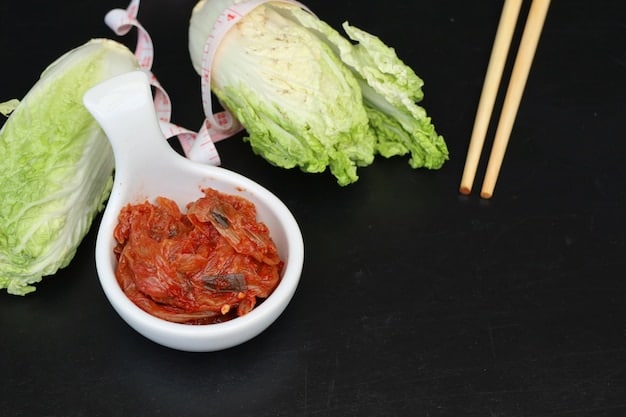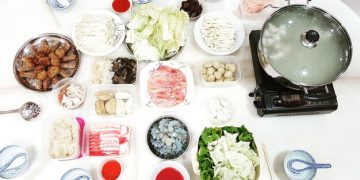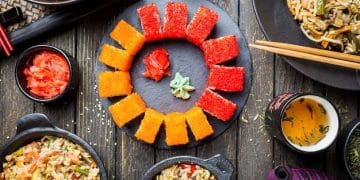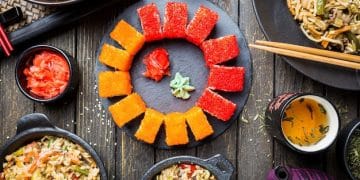The Art of Kimchi Making: A Step-by-Step Guide for US Home Cooks

The Art of Kimchi Making: A Step-by-Step Guide for US Home Cooks offers a comprehensive exploration of this iconic Korean dish, providing American home cooks with detailed instructions, ingredient insights, and cultural context to confidently create their own delicious kimchi variations.
Embark on a culinary journey and discover the art of kimchi making: a step-by-step guide for US home cooks. Learn how to create this flavorful and healthy Korean staple in your own kitchen, using readily available ingredients and straightforward techniques.
Understanding Kimchi: A Korean Culinary Staple
Kimchi is more than just a side dish in Korea; it’s a cultural icon and a daily essential. Understanding its significance and variations is the first step to mastering the art of making it at home.
From its humble beginnings as a method of preserving vegetables for the winter months to its current status as a global superfood, kimchi has a rich history. Let’s delve into what makes kimchi so special.
The History and Cultural Significance of Kimchi
Kimchi’s roots trace back centuries, evolving from simple salted vegetable preparations to the complex and diverse varieties we know today. Its cultural importance is deeply ingrained in Korean society.
- Kimchi is a staple in almost every Korean meal, served alongside rice and other dishes.
- Different regions in Korea have their own unique kimchi recipes, reflecting local ingredients and preferences.
- Kimchi-making, or “kimjang,” is a traditional communal activity, often involving families and neighbors.
Exploring the Health Benefits of Kimchi
Beyond its delicious flavor, kimchi offers a wealth of health benefits, making it a popular choice for health-conscious individuals.
- Kimchi is rich in probiotics, which promote gut health and boost the immune system.
- It’s a good source of vitamins and minerals, including vitamin C, vitamin K, and iron.
- The fermentation process enhances the nutritional value of the vegetables used in kimchi.
- Studies have suggested that kimchi may have antioxidant and anti-inflammatory properties.
Kimchi is a testament to the power of fermentation and its ability to transform simple ingredients into a culinary masterpiece. Understanding its cultural and health significance enriches the experience of making and enjoying it.
Essential Ingredients for Authentic Kimchi
The quality of your kimchi depends heavily on the ingredients you use. Sourcing the right components is key to achieving that authentic Korean flavor.
While you can adapt recipes to suit your taste, certain ingredients are essential for a true kimchi experience. Let’s explore the must-haves for your kimchi-making journey.

Navigating the Spice: Gochugaru (Korean Chili Powder)
Gochugaru is the heart and soul of kimchi, imparting its signature red color and spicy kick. Choosing the right type is crucial.
- Look for Korean gochugaru, as it has a unique flavor and texture that differs from other chili powders.
- The coarseness of the gochugaru affects the kimchi’s texture and spice level. Experiment to find your preference.
- Store gochugaru in a cool, dark place to preserve its flavor and color.
The Foundation: Napa Cabbage and Korean Radish
Napa cabbage and Korean radish provide the bulk and texture of most kimchi varieties. Their freshness and quality directly impact the final product.
- Choose firm, heavy napa cabbages with tightly packed leaves.
- Korean radishes, also known as “mu,” are denser and slightly sweeter than other radish varieties.
- Make sure both vegetables are free from blemishes and signs of spoilage.
The Umami Boosters: Fish Sauce and Salted Shrimp
Fish sauce and salted shrimp (saeujeot) add depth of flavor and umami to kimchi. These fermented ingredients are essential for an authentic taste.
These are the key ingredients, and understanding how they interact is crucial for great kimchi.
Step-by-Step Guide to Making Napa Cabbage Kimchi
Napa cabbage kimchi (baechu kimchi) is the most popular and widely recognized type of kimchi. This step-by-step guide will walk you through the process.
From preparing the cabbage to mixing the seasonings, we’ll cover each stage in detail, ensuring you have all the information you need to succeed. It’s all about process, so let’s get started!
Step 1: Preparing the Napa Cabbage
Properly preparing the napa cabbage is crucial for achieving the right texture and flavor in your kimchi.
- Cut the napa cabbage lengthwise into quarters and remove the core.
- Brine the cabbage in a salt water solution for several hours to soften the leaves and draw out excess moisture.
- Rinse the cabbage thoroughly under cold water and drain well before proceeding.
Step 2: Making the Kimchi Paste
The kimchi paste is where all the flavors come together. This is where you get to be creative and adjust the spice level to your liking.
This part of the process is very important, take your time and follow these tips.
Step 3: Assembling and Packing the Kimchi
With the cabbage prepped and the paste ready, it’s time to assemble your kimchi. This involves carefully coating each leaf with the seasoning mixture.
- Wear gloves to prevent your hands from staining and to avoid chili burn.
- Spread the kimchi paste evenly between each leaf, ensuring every part is coated.
- Fold the cabbage quarters into tight bundles and pack them tightly into a clean jar or container.
The key to this step is to make sure to pack tightly to keep out as much air as possible.
Fermentation: The Key to Kimchi’s Unique Flavor
Fermentation is the magic behind kimchi’s distinctive taste and health benefits. Understanding this process will help you create the perfect kimchi every time.
It involves beneficial bacteria transforming the vegetables and seasonings, resulting in a complex flavor profile. Fermentation can take time, but don’t skip this step!

Understanding Anaerobic Fermentation
Kimchi fermentation is an anaerobic process, meaning it occurs without oxygen. This environment promotes the growth of beneficial bacteria.
- The lacto-fermentation process converts sugars into lactic acid, which preserves the vegetables and gives kimchi its sour taste.
- Maintaining an airtight environment is crucial for successful fermentation.
- Use a jar with an airlock or burp the jar daily to release excess gases.
Factors Affecting Fermentation Time
Several factors influence the speed and quality of kimchi fermentation. Controlling these variables allows you to fine-tune the process to your liking.
- Temperature plays a significant role. Warmer temperatures accelerate fermentation, while cooler temperatures slow it down.
- Salt content also affects fermentation. Too little salt can lead to spoilage, while too much can inhibit fermentation.
- The amount of sugar or starch in the ingredients can influence the fermentation rate.
Monitor your kimchi closely during fermentation, tasting it regularly to gauge its progress. The longer it ferments, the sourer and more complex the flavor will become. Adjust the fermentation time based on your taste preferences.
Kimchi Variations: Exploring Different Recipes
Once you’ve mastered the basic napa cabbage kimchi, venture into the world of kimchi variations. There’s a kimchi recipe to suit every taste and preference.
Different vegetables, seasonings, and fermentation techniques can create a wide range of kimchi flavors and textures. Experiment and discover your favorites.
Kkakdugi: Cubed Radish Kimchi
Kkakdugi is a popular kimchi made with cubed Korean radish. It has a crunchy texture and a refreshing flavor.
Oi Sobagi: Cucumber Kimchi
Oi sobagi is a tangy and refreshing kimchi made with cucumbers. It’s a great option for warmer months.
Learning to make kimchi is an ongoing process. Don’t be afraid to experiment with different ingredients and techniques to create your own unique kimchi recipes.
Serving and Storing Your Homemade Kimchi
Proper serving and storage are essential for preserving the flavor and quality of your homemade kimchi. Here are some tips to ensure your kimchi stays delicious for as long as possible.
How you serve and store your kimchi can greatly affect its taste and shelf life. Let’s cover some do’s and don’ts to help you get the most out of your kimchi.
Serving Suggestions for Kimchi
Kimchi is incredibly versatile and can be enjoyed in numerous ways. Here are some serving suggestions to get you started.
- Serve kimchi as a side dish with rice, meat, or tofu.
- Use it as an ingredient in stews, soups, and stir-fries.
- Make kimchi fried rice by stir-frying cooked rice with kimchi, vegetables, and protein.
Proper Storage Techniques for Kimchi
Storing kimchi correctly helps to slow down fermentation and prevent spoilage.
- Store kimchi in airtight containers in the refrigerator.
- Use a clean utensil each time you take kimchi from the jar to prevent contamination.
- Press down on the kimchi to keep it submerged in its juices.
Kimchi will continue to ferment in the refrigerator, becoming sourer over time. If you prefer a milder flavor, consume it within a few weeks of making it. Enjoy the fruits (or vegetables!) of your labor.
| Key Point | Brief Description |
|---|---|
| 🌶️ Gochugaru | Korean chili powder, essential for color & spice. |
| 🥬 Napa Cabbage | The main ingredient, needs brining before use. |
| 🐟 Fish Sauce | Adds umami flavor, can be substituted. |
| ⏳ Fermentation | Allows flavors to develop. Time varies with temperature. |
Frequently Asked Questions About Kimchi
▼
Yes, you can! Radishes, cucumbers, and scallions are popular alternatives. Consider seasonal availability and your personal preferences when choosing vegetables for your kimchi.
▼
Absolutely! Replace fish sauce and salted shrimp with kelp powder or vegetable broth for umami flavor. Ensure all components are vegan-friendly for a delicious plant-based kimchi.
▼
Control the amount of gochugaru (Korean chili powder) in the paste. Start with less and add more to taste. For less heat, remove seeds from the chili peppers.
▼
Bubbles in the jar are a sign that you’re doing it correctly! As long as you packed it tight with as little access to air as you could. Taste-test it to see how it tastes.
▼
When properly stored, homemade kimchi can last for several months in the refrigerator. The flavor will change over time, becoming more sour and intense with longer fermentation.
Conclusion
Making kimchi at home is a rewarding experience that allows you to connect with Korean culture and enjoy a flavorful and healthy dish. With this step-by-step guide, you can confidently embark on your kimchi-making journey and create delicious variations that suit your taste. Experiment with different ingredients, adjust the spice level, and enjoy the art of kimchi making!





